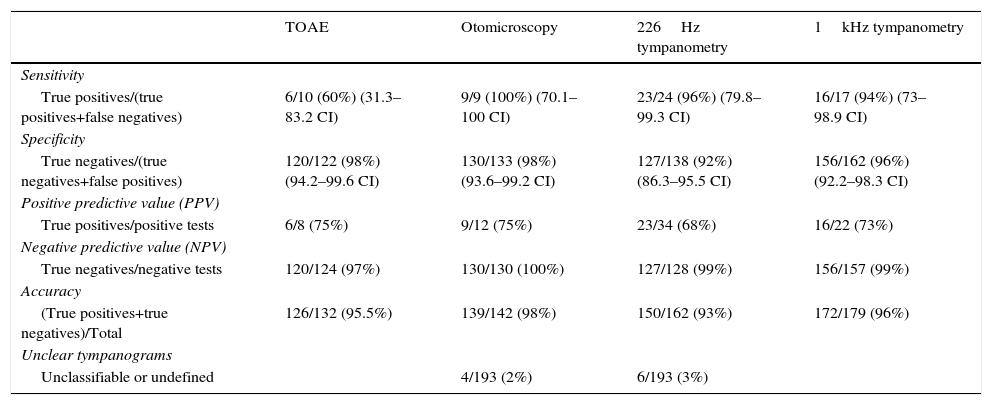In the first 6 months of life, 226Hz tympanometry is considered an ineffective procedure for the diagnosis of otitis media with effusion. With the introduction of universal hearing screening, the use of high frequency 1000Hz (1kHz) tympanometry has been recommended. To optimise the diagnosis of neonatal hearing loss, we present this comparison, from the clinical point of view, of the results of 226Hz and 1kHz tympanometry in infants.
Materials and methodsWe designed a prospective study of 100 children under 9 months of age proceeding from our hearing screening programme. We compare the result of tympanometry with binocular microscopy and transient evoked otoacoustic emissions.
ResultsThe application of transient otoacoustic emissions, otomicroscopy and 226Hz and 1kHz tympanometry has shown its usefulness in the management of otitis media with effusion of young infants, with a similar effectiveness between the 4 tests.
ConclusionThe joint use of otomicroscopy, transient otoacoustic emissions and 226Hz and 1kHz tympanometry, has allowed us to diagnose otitis media with effusion in young infants more accurately than each test separately. We recommend initial use of 1kHz tympanometry, at least in children younger than 7 months, but in the presence of hearing loss or an unclear result, 226Hz tympanometry is a good diagnostic complement.
La timpanometría de baja frecuencia (226Hz) se considera un procedimiento ineficaz para el diagnóstico de la otitis media serosa en los primeros 6meses de la vida. Con la implantación del cribado auditivo universal, se recomienda la utilización de la timpanometría de alta frecuencia de 1.000Hz. A fin de optimizar el diagnóstico de la hipoacusia neonatal presentamos este trabajo donde comparamos, desde el punto de vista clínico, los resultados timpanométricos de 226Hz y de 1kHz.
Material y métodoEstudio prospectivo de 100 niños menores de 9 meses procedentes del cribado auditivo. Comparamos el resultado de la timpanometría con la otomicroscopia y con las otoemisiones acústicas transitorias.
ResultadosLa aplicación de las otoemisiones acústicas transitorias, la otomicroscopia y la timpanometría de 226Hz y de 1kHz ha mostrado su utilidad en el manejo de la otitis media serosa del lactante, con una validez similar entre las 4 pruebas.
ConclusiónEl uso conjunto de la otomicroscopia, las otoemisiones acústicas transitorias y la timpanometría de 226Hz y de 1kHz nos ha permitido diagnosticar la otitis media serosa del lactante con mayor precisión que si aplicáramos estas pruebas de forma aislada. Se aconseja utilizar inicialmente la timpanometría de 1kHz, al menos en niños menores de 7 meses, pero en presencia de hipoacusia o de un resultado confuso, la timpanometría de 226Hz es un buen complemento diagnóstico.











